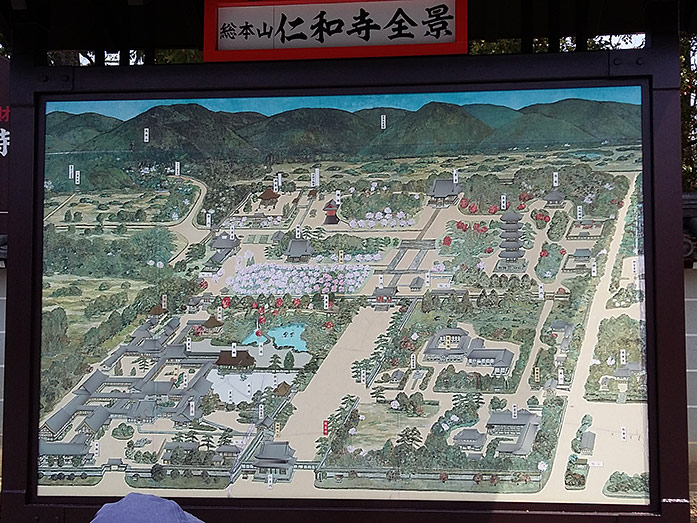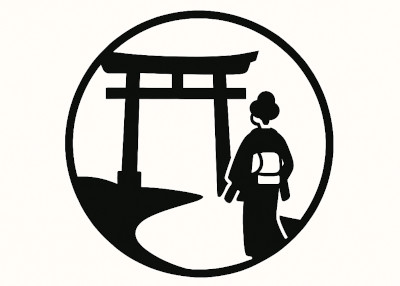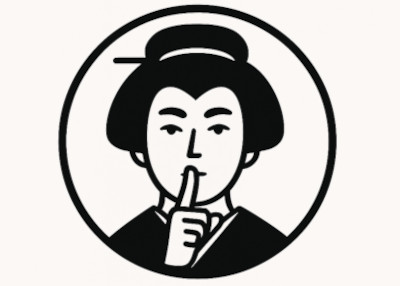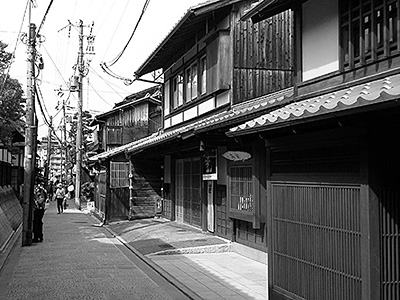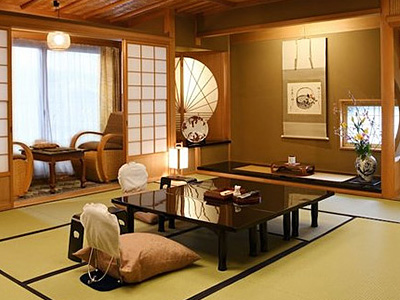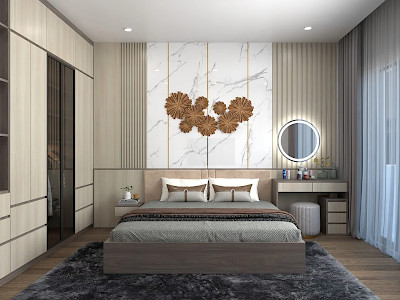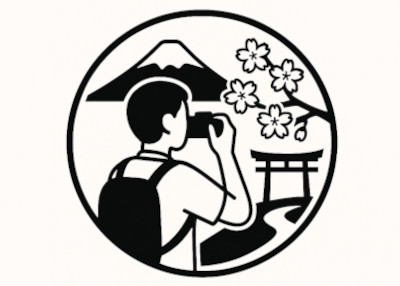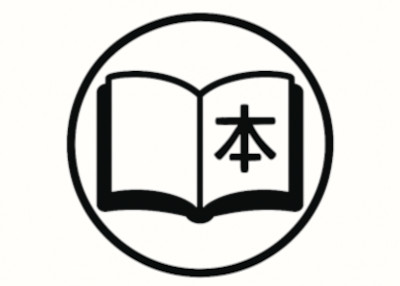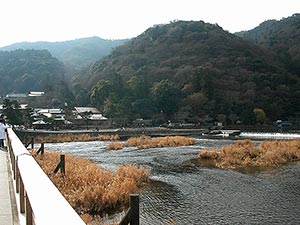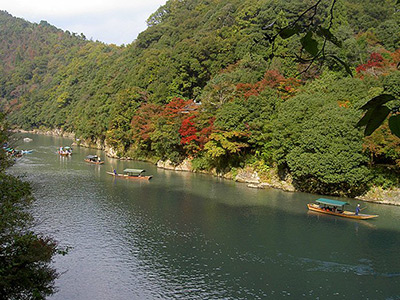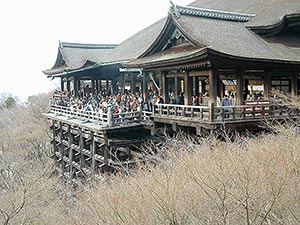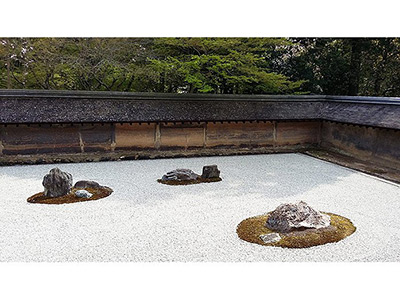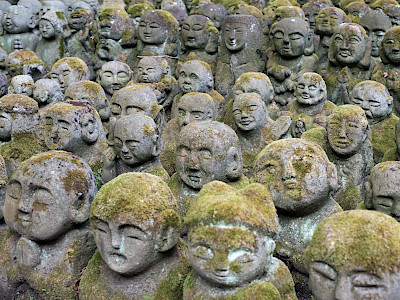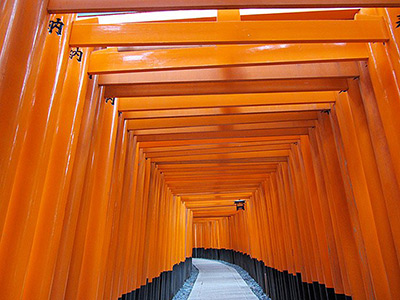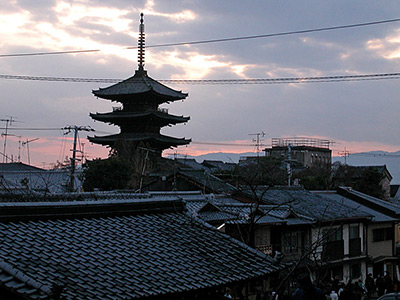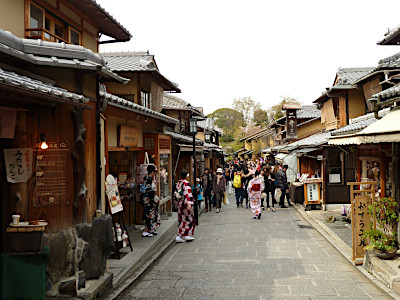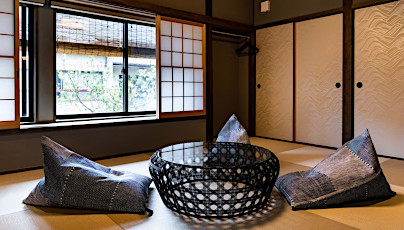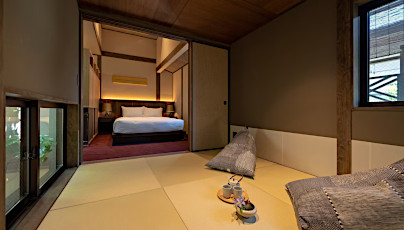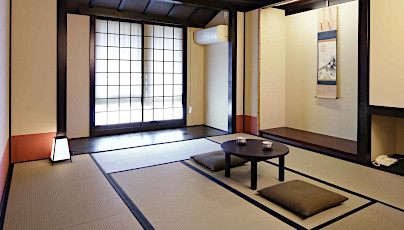Ninnaji Temple in Kyoto
This post can contain affiliate links, which means that we may receive a small commission if you make a purchase using these links.
Facts & Figures
Ninnaji (former Omuro Imperial Palace) is a UNESCO World Heritage Site and belongs to the group of Historic Monuments of Ancient Kyoto. The temple serves as the headquarters of the Omuro school of the Shingon Sect of Buddhism. Enter the Ninna-ji temple grounds through the huge and impressive Nio-mon Gate and you will find yourself in a different world.
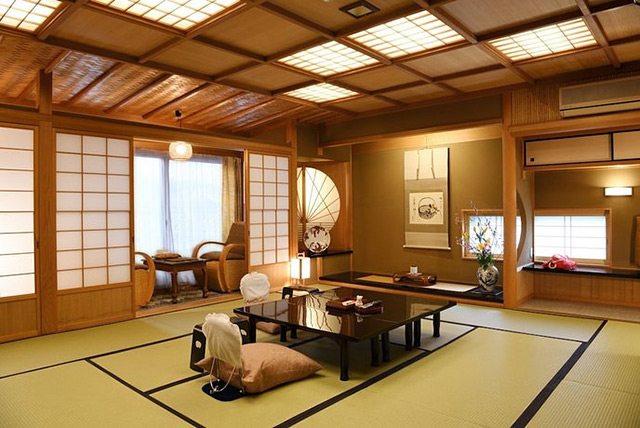 Experience the Ultimate Japanese Hospitality at a Kyoto Ryokan.
Experience the Ultimate Japanese Hospitality at a Kyoto Ryokan.
Find Your Perfect Ryokan Now >
My must-see recommendations for you are the Five-Storied Pagoda, Kon-do (Main Hall and National Treasure), Omuro-zakura Trees, Chu-mon Gate, Syoro Bell Tower, and of course the Goten Complex (the main residence halls of the imperial chief priest). My tip: Ninna-ji belongs to the most popular cherry blossom spots in Kyoto.
- Ninna-ji:
- Opening Hours - 9:00 am to 5:00 pm (last entry 4:30 pm, Mar till Nov)
- Opening Hours - 9:00 am to 4:30 pm (Dec till Feb, last entry 4:00 pm)
- Closed - never, open the whole year
- Admission Fee only for Goten Palace Buildings - 500 yen (Adults + High School Students), 300 yen (Junior High School and Elementary School Students)
History
Emperor Koko (830 – 887) gave in 886 the order for the construction of Nishiyama Gogan-ji Temple. After his death Emperor Uda (867 – 931) finished the project in 888 and gave the temple the name Ninna-ji. After he retired in 897 Emperor Uda devoted himself to practice Shingon Mikkyo (Esoteric Buddhism). Since that moment it was a tradition to send a member of the imperial family to serve as the abbot at this temple. This ritual was maintained until the Meiji Restoration. During the Onin War in 1467, most of the temple complex was destroyed by fire. Under the 21st abbot Prince Kakushin (1588–1648) and with the financial support of the Tokugawa Shogunate the temple grounds could be restored in the 17th century. Most of the buildings you see today date back to this time. In 1994 Ninna-ji received the status of a UNESCO World Heritage Site.
Location

Ninna-ji is located near Omuro Station and Ryoan-ji Zen Temple within the Ukyo district in Kyoto.
Address: 33 Omuro-ouchi, Ukyo-ku, Kyoto 616-8092
How to get to Ninna-ji Temple?
- 2min walk from Omuro Ninna-ji Station served by Keifuku Railway Kitano Line
- 30min from Kyoto Station to Omuro-Ninna-ji stop by JR bus (Japan Rail Pass covers the ride)
Sightseeing spots within the Ninnaji Temple complex
Top:
Kon-do (Main Hall) - The former throne hall (Shishin-den) of the Imperial Palace in Kyoto was built in 1613 and later moved to this location. Kon-do enshrines a golden image of Amitabha Buddha which is considered a National Treasure in Japan.
Five-Storied Pagoda - The height of this beautiful pagoda is 36,18m. This important cultural property was built during the Edo Period in 1637. What makes the structure of the pagoda so special is that the width of each story is almost the same. To make the pagoda resistant to earthquakes one main pillar (shinbashira) was used throughout the whole structure. The walls and pillars are decorated with paintings of Buddhist images.
Nio-mon Gate - Nio-mon belongs to the three most famous and important temple gates in Kyoto. The other two are the Sanmon Gate at Nanzen-ji Temple and the Sanmon Gate at Chion-in Temple. The height of this gigantic gate, which was rebuilt in 1637, is 18,7m. The angry-looking Niozou Statues, Agyo, and Ungyo are placed at the entrance and the Karajishizou Statue is on the back.
Syoro Bell Tower - The huge belfry (Shoro) is an architectural masterpiece of the Edo Period. It has been designated as an Important Cultural Property.
Goten (Omuro Palace) Complex - It was the main living quarters of Monzeki (imperial chief priest). The complex consists of the Shinden (main residence), Shiro-shoin, Kuro-shoin, and Reimeiden. These buildings are connected by roofed corridors and gardens (Dantei - South Garden, Hokutei - North Garden). Do not miss the beautiful Fusuma-e paintings at the sliding doors of Kuro-shoin by Insho Domoto (1891 - 1975). In 1887 the Goten Complex was destroyed by fire and rebuilt about 20 years later.
200 Omuro-sakura Trees - This place was designated as a National Scenic Beauty Spot in 1924. I enjoyed my time there during the cherry blossom season.
Reihokan (Treasure House) - The Treasure House is only open during the year from the 1st of April to the 4th of May and from the 1st of October to the 23rd of November. You have to pay a 500 yen admission fee. It contains Buddha statues like the Amida-Nyorai Buddha statue, old documents, furniture, paintings, textiles, and calligraphy scrolls by famous Japanese Buddhist monk Kobo Daishi (774 - 835).
Festival & Events in Kyoto (dates can change without notice)
April
Sakura Matsuri at Ninna-ji Temple (till middle of April)
Enjoy the beautiful cherry blossom season and walk through the little park behind the Chu-mon Gate.
Miyako Odori (1st - 31th)
The traditional annual spring dance of the Kyoto district Gion Kobu performed by Geiko and Maiko is a must-see on your Kyoto visit. Don't miss the most popular dances the Miyako Odori "Cherry Blossom Dances" or "Dances of the Old Capital" at the Gion Kobu Kaburenjo Theater (located close to Gion Corner).
May
Aoi Matsuri (15th)
The highlight of this festival is a large parade from the Imperial Palace through the Shimogamo Shrine to the Kamigamo Shrine. More than 500 people wearing aristocratic costumes from the Heian Period (794 - 1185). The Aoi Matsuri belongs with the Gion Matsuri and Jidai Matsuri as the three most famous festivals in Kyoto.
July
Gion Matsuri (whole month)
The month of July is full of different events like the Yoiyama - Kyoto's Magical Night (locals in kimonos look at the giant Gion floats the day before the parade) or the famous Yamaboko Junko (float procession on the 17th of July).
Obon Festival at Higashi Honganji Temple (30th - 31st)
The annual summer Obon Festival honors the spirit of our ancestors. You can enjoy there tea ceremony demonstrations, games, flower market, delicious food, Bon Odori Dancing and much more.
October
Jidai Matsuri ("Festival of Ages") (22nd)
People celebrate with a large parade between Imperial Palace to Heian Shrine the anniversary of the foundation of Kyoto. App. 2000 participants wearing historical costumes from different time periods. Enjoy this great festival which lasts around 2 hours.
Where to stay in Kyoto?
Book your Flight Tickets and Rental Car for your Japan trip
Day trips from Kyoto:
Travelers who viewed Ninna-ji Temple viewed also:
Top rated - Best Machiya Houses in Kyoto
THE MACHIYA Ebisuya, 192 Ebisuya-cho Shimogyo-ku, Kyoto 600-8062
This 3-star guesthouse got an excellent rating. All 30 individually furnished rooms offer free WiFi, air conditioning, bathrooms incl. toilets, fridges, 40-inch flat-screen TVs, and more. THE MACHIYA Ebisuya is located in central Kyoto.
View on Expedia.com
This 3-star guesthouse got an excellent rating. All 30 individually furnished rooms offer free WiFi, air conditioning, bathrooms incl. toilets, fridges, 40-inch flat-screen TVs, and more. THE MACHIYA Ebisuya is located in central Kyoto.
View on Expedia.com
The Machiya Kazahaya, 570-6 Kazahayacho, Shimogyo-ku, Kyoto, Kyoto, 600-8475
The Machiya Kazahaya offers for all guest rooms free WiFi, air conditioning, safes, bathrooms with toilets, refrigerators, and much more. Enjoy also the beautiful Japanese Garden. Guests gave this property the rating - Exceptional.
View on Expedia.com
The Machiya Kazahaya offers for all guest rooms free WiFi, air conditioning, safes, bathrooms with toilets, refrigerators, and much more. Enjoy also the beautiful Japanese Garden. Guests gave this property the rating - Exceptional.
View on Expedia.com
Kyomachiya Ryokan Sakura Urushitei, 425 Kichimonjicho, Shimogyo-ku, Kyoto, 600-8069
This beautiful 3-star guesthouse offers 32 rooms with free WiFi, air conditioning, bathrooms incl. showers and toilets, refrigerators, and much more. Enjoy also the relaxing indoor public bath (no minerals). Guests gave this property the rating - Wonderful.
View on Expedia.com
This beautiful 3-star guesthouse offers 32 rooms with free WiFi, air conditioning, bathrooms incl. showers and toilets, refrigerators, and much more. Enjoy also the relaxing indoor public bath (no minerals). Guests gave this property the rating - Wonderful.
View on Expedia.com



